Abstract
This study is an experiment that looks at what happens when 18 supported reinforced concrete beams with waste glass inside them are put on fire. All the supported beams were tested under a three-point load. We classified the beams into three groups based on the glass-to-sand replacement ratio. Two sand replacement ratios (10% and 20%) were considered and compared with the control beams (without replacement). Two periods of burning were studied to investigate the mechanical properties of ferrocement and the behavior of simply supported beams. We considered a temperature of 550 °C and gradually increased the burning to reach this degree. Mode failure, mechanical properties, and load–deflection were present in this study. According to this study and its results, it seems that approximately all mode failures were compound flexural and shear failures. The flexural and compressive strength of replacing sand with glass concrete leads to an improvement in the flexural behavior of the reinforced concrete beam incorporating waste glass (brittle failure) that happened when burning the beam element without sand replacement glasses. The replacement ratio (10%) is the best value of the replacement ratio of the glasses; the compressive strength increased by about 10% to 29% by the replacement ratio. When replacing 10% of the sand with glasses, the ratio increases from 1% to 16%, but the compressive strength decreases from 20% to 51% when the burning time increases from one hour to an hour and a half. When 10% of the sand is replaced by glasses by weight, the first crack load capacity goes up by about 8% for one hour of burning and by 16% for one hour and a half of burning compared to beams that are not burning. The ultimate load capacity also goes up by about 17.5% for one hour of burning and by 23.5% for one hour and a half of burning compared to beams that are not burning. Otherwise, sand replacement was 10% by glasses; by weight, the ultimate load strength increased about 6% when the burning was one hour and 12% when the burning was one hour and a half compared with the beams without burning for the same phase.
1. Introduction
Fire is still one of the most earnest potential dangers to most buildings and structural elements. The defect of structural materials when exposed to fire has the potential for building failure. Therefore, the use of additional materials to reduce thermal damage to structural members is substantial and necessary [1]. We have evolved many types of fire-added material to protect structural elements [2]. The main classes of material used are cementitious, intumescent, fibrous, and composite materials. In recent years, cementitious materials that have been treated differently or with additives have been studied. For example, material concrete mix replacement and different types of concrete, such as high-strength concrete, reactive powder concrete, and ferrocement concrete, have been looked at. In this study, glass was used instead of fine aggregate to make the concrete lighter and better in terms of its physical properties. One type of cementitious composite material is ferrocement, which is made of hydraulic cement mortar reinforced with layers of continuous, relatively small wire mesh that are close together [3]. By substituting a lightweight substance for natural sand, the structure’s self-weight is decreased, enabling the construction of larger structures or smaller structural elements [4]. As a result, there will be a commercial benefit since the construction will cost less due to the use of fewer resources. It is beneficial to employ waste materials in construction because they can yield a material (like concrete) with sufficient performance and provide both financial and environmental advantages [5]. For instance, substituting recycled aggregates, whether fine or coarse, could reduce the quantity of waste that ends up in landfills and the quantity of natural resources that are frequently utilized in concrete [6].
1.1. Glass Replacement in Concrete
Although it can be used alone in buildings, lightweight concrete with recycled expanded glass as an aggregate cannot support weight. Expanded glass concrete was shown to have excellent thermal conductivity; as a result, it can be suggested as a coating material for buildings. A furnace crushes glass into a powder, mixes it with water and expanding chemicals, and then heats it to 900 °C to create expanded glass [7]. This procedure creates expanded glass. Several sizes of expanded glass can be made. Sizes ranging from 1–2 mm to 0.5–0.25 mm were utilized for this study because they were thought to be appropriate for replacing sand. It looked into how well-expanded glass works in applications involving reinforced concrete [8]. It presents the findings of an experimental study on the compressive strength and flexural behavior of reinforced concrete that uses expanded glass in place of fine aggregate, either entirely or partially [9].
1.2. Fire Effect on Concrete
Fires usually happen by accident and do not spread very far. However, they can do a lot of damage to structures if they are exposed for a long time or if the materials that can catch fire have a high calorific value. In cases where these conditions are not met, fire damage is typically less significant in practical terms. However, structural assessments by specialized engineers or architects remain essential. When exposed to fire, concrete undergoes the evaporation of capillary water at temperatures ranging from 100 to 300 °C [10].
2. Review of Previous Research
To make it easier to compare, many studies have looked at how changing the replacement ratios affects the properties of fiber-reinforced cement concrete and how the length of time a beam is exposed to fire affects its performance, as well as the effect of fire exposure duration on beam performance and fire effect on the structural behavior of construction elements.
Iman Abdel Rahman, Hussam Essam, and Ibtihal Salem, 2011 [11], examined the impact of locally crushed waste glass as a fine aggregate replacement on the properties of mortar. Their study involved five mortar mixtures in which broken waste glass substituted sand at five different weight percentages (0%, 25%, 50%, 75%, and 100%) using locally sourced cement and sand. The findings revealed a reduction in both dry density and compressive strength as the proportion of crushed glass increased. Additionally, water absorption rose with higher glass content. The study concluded that up to 25% of sand could be replaced with crushed glass without significant adverse effects.
H. Dabiri A., M. K. Sharbatdar, A. Kavyani, and M. Baghdadi, 2018 [12], investigated the use of waste glass in concrete as a sustainable alternative to conventional aggregates. Given the environmental challenges posed by glass waste, particularly non-biodegradable colored glass, recycling such materials offers a viable solution. Their study assessed the effect of substituting aggregates with waste glass particles on concrete’s compressive strength and mass. A total of twenty-seven cubic specimens were produced, six of which contained only concrete, while the others incorporated waste glass particles. To mitigate the alkali–silica reaction (ASR), micro-silica was added to the glass-containing mixtures. The results indicated that replacing more than 30% of the aggregate with glass particles enhanced the compressive strength, while the mass of concrete remained relatively consistent across all specimens. The optimal substitution proportion was identified as 50%.
Jamal Khatib, Adrian Jefimiuk, and Sammy Khatib, 2015 [9], explored the flexural behavior of reinforced concrete beams in which expanded glass partially replaced fine aggregate (sand). Their study involved four concrete mixtures with varying proportions of expanded glass (0%, 25%, 50%, and 100% by volume). The findings demonstrated that incorporating 50% expanded glass improved concrete workability. However, compressive strength declined proportionally with increasing glass content. Additionally, while ductility was significantly enhanced, the load-bearing capacity and initial cracking load were reduced. Despite these limitations, expanded glass was deemed viable for structural concrete applications.
Aper E. Zava, Samson N. Apebo, and Paul T. Adeke, 2020 [13], examined the effects of glass sand on concrete properties and identified the optimal proportion of waste glass aggregate for fine aggregate replacement. The study involved producing concrete specimens with varying glass sand content and evaluating both fresh and hardened concrete characteristics. The results showed that glass sand had a minimal effect on workability, and the density of concrete with glass sand was only 1–2% lower than that of conventional concrete. The strength–time relationship remained unchanged, and compressive strength increased with extended curing. A parabolic relationship was observed between concrete strength and glass sand content, with the maximum strength achieved at 10% glass sand replacement, yielding 1.2 times the target strength of 25 N/mm2. It was found that 16% replacement was the best level for grade C25 concrete, and extra cementitious materials should be used to counteract any ASR effects that might happen.
Samuel Cameli Fernandez, 2019 [14], emphasized waste reutilization as a key strategy for sustainable development. He highlighted that sustainability, as defined by the World Commission on Environment and Development, involves meeting present needs without compromising future generations. His research focused on optimizing the percentage replacement of sand and gravel with crushed waste glass in concrete to reduce costs, conserve raw materials, and minimize landfill waste. We sourced waste glass samples from construction sites and glassware industries and then processed them to achieve the appropriate granulometry. Natural aggregate-based concretes and glass aggregate-based concretes were compared at replacement levels of 20%, 30%, 40%, and 50%. The study evaluated compressive and diametric tensile strength over periods of 7, 14, 21, 28, and 90 days.
Louise Gallagher, 2019 [15], explored alternative materials to sand due to its depletion and associated environmental concerns. Among these alternatives, glass has shown promise as a sustainable substitute. Large quantities of discarded sheet glass currently end up in landfills with minimal recycling efforts. The incorporation of glass powder into concrete production offers dual benefits—reducing waste disposal costs and conserving natural resources. This study examined the feasibility of using glass powder as a fine aggregate substitute at replacement levels of 10%, 25%, and 50%. Comparative analyses assessed compressive strength, tensile strength, and flexural strength relative to conventional concrete. Durability testing also included rapid chloride penetration, acid resistance, and sulfate attack. The result showed better strength characteristics of the glass powder concrete, and it can be used as an alternative to natural sand-based concrete.
An investigation on the use of waste glass (WG) as fine aggregate in concrete mixtures was conducted by Mohammad F. Ahmed, Abbas Hadi Abbas, and Raed M. Abdulah (2011) [16]. WG was replaced (0%, 33%, 66%, 100%) and ground to meet Iraqi sand requirement No. 45. The effect of this on compressive strength and unit weight was also studied. It was found that both parameters were significantly reduced with an increased WG content. However, the cost analysis showed that WG use in concrete production is possible, given the reduced concrete production costs incurred from its use.
Esraa Emam Ali’s research in 2012 [17] looked at what would happen if recycled glass chips were used in place of some fine aggregate in self-compacting concrete (SCC). In this study, eighteen concrete mixtures were set up with three cement contents (350, 400, and 450 kg/m3) at a constant water-to-cement ratio of 0.4. The replacement levels of 0%, 10%, 20%, 30%, 40%, and 50% were incorporated into recycled glass. These findings showed that as the amount of glass in the material went up, the slump flow went up and the compressive strength, splitting tensile strength, flexural strength, and static modulus of elasticity went down. However, the results demonstrated that the production of SCC could effectively utilize recycled glass aggregate.
M. Adaway and Y. Wang, 2015 [18], investigated the ratio of glass replacement for the maximum compressive strength. They tested fine glass aggregate replacements of 15%, 20%, 25%, 30%, and 40% on concrete samples at 7 and 28 days. The experimental results show that the inclusion of 30% glass decreased compressive strength by 30% beyond that of conventional concrete at 7 days by 9% and at 28 days by 6%. This would imply that the use of up to 30% aggregate glass helps improve strength development.
In 2018, Kunal Bisht (2018) [19] studied the mechanical and durability properties of reclaimed fine concrete aggregates when replacing waste glass at up to 24% and 18%. Workability, compressive strength, flexural strength, density, and water absorption were assessed within the study. The study demonstrated that replacing glass by up to 21% enhanced microstructural quality and mechanical performance. Above this threshold, however, extra water material absorption and permeability hurt durability. For a non-aggressive environment, the results showed that a 21% replacement level is optimum.
However, based on the above research, this study aims to find out the behavior of ferrocement concrete beams that are incorporated with waste glass directly under the influence of fire. To achieve this aim, changing the ratio of sand replacement with glasses will be studied to investigate the effect of this parameter on the physical properties of the concrete while also studying the effect of direct fire on the self-compacted concrete beam and the time of burning on the behavior of beams.
3. Experimental Program
3.1. Material Characteristics
The materials used in this study are illustrated in Figure 1 and consist of cement, fine aggregate (sand) with a maximum aggregate size of 5 mm (according to the information given in Table 1), glass particles from 0.2 to 1.18 mm, a superplasticizer, and water. The research took place with three different concrete mixtures in which foamed expanded glass was used as fine aggregate as a partial or total replacement by volume at replacement levels of 10%, 20%, and 100%. To maintain a constant cement-to-fine aggregate weight ratio, the weight of water was kept constant to maintain a water-to-cement ratio of 0.33 for all mixtures. Because expanded glass is a highly porous material with a higher water absorption capacity than natural sand, it was necessary to use a superplasticizer to compensate for the elevated water demandas in Table 3.
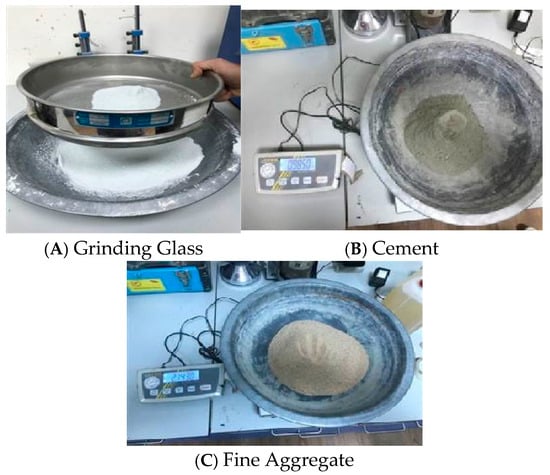
Figure 1.
Samples of Grinding Glass, cement and fine aggregate.

Table 1.
Sieve analysis of fine aggregate.
3.2. Grinding Glasses and the Testing Procedure
The electric mill and Los Angeles apparatus were used to grind the glasses; the first stage was to crush the local glass bottles into small pieces and then grind them and calculate all the passing weight from the sieve (No. 1.18), as shown in Figure 2. It was observed that when using a replacement of sand with glass, the workability of concrete has become less, so some improved materials must be used to obtain acceptable workability and reduce water and porosity. The improvers give excellent properties to the concrete in its fresh and firm state. One of these plasticizers is the superplasticizer, as shown in Table 2. This material complies with the American Standard ASTM C494 Type A, G [21].
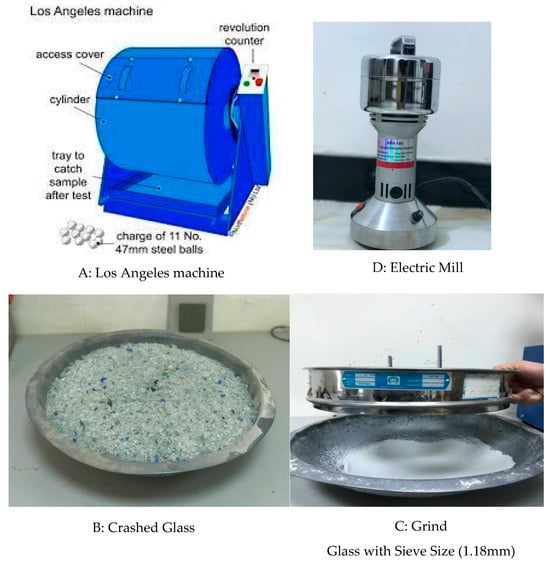
Figure 2.
Glass treatments.

Table 2.
Properties of steel bars.
For each mix shown in Table 3, it cast nine cubes (50 × 50 mm) and six beams (1000 × 200 × 200 mm), according to ACI code 318-19 [22] with four bars as reinforcement (Ф 10 mm @ 150 mm). Tensile tests were conducted on several specimens (at least three) prepared from the steel reinforcement bars that were used in the tested beams. Static yield stress and the ultimate strength of the tested bars are summarized in Table 2 by ASTM A615/A615M-13 [23].

Table 3.
Mix properties.
The beams were cast in wood molds, and both the cubs and beams were cured and tested after 28 days, as shown in Figure 3. The compressive strength testing of the concrete cubes was considered in accordance with BS EN 12390-3:2009 [24].
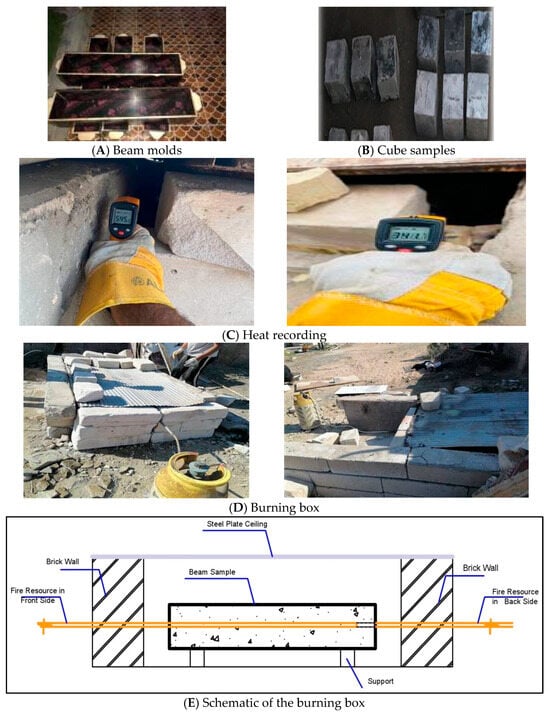
Figure 3.
Testing and molds.
Both cubes and beams were divided into three groups according to the ratio of glass replacement, and each group, which consists of nine cubes and six beams, was tested in three phases: the first phase with no burning, the second phase included burning for one hour, and the third phase included burning for one hour and a half in a local furnace, as simulated in Figure 3D. The burning happened in a brick box covered by a steel plate, and the temperature was recorded and rose gradually until it reached the peak value (550 °C) and was then tested.
4. Results and Discussion
We illustrate and discuss the results of the test beams and cubes. The relationship between the load and deflection of the tested beams is considered. The discussion includes flexural behavior and ultimate bending capacities. As shown in Figure 4, we tested 18 simply supported beams with variable parameters until they failed under a three-point load system. The main variables considered in this study were the replacement ratio of glasses and the time of burning. Figure 5 displays the average compressive strength of three cubes for each replacement ratio and burning time.
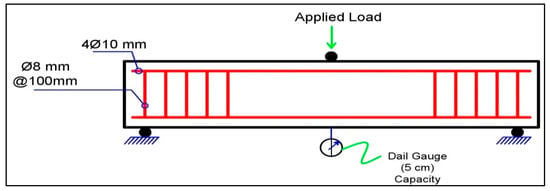
Figure 4.
Schematic of the test setup.

Figure 5.
Relation between burning time and the glass replacement ratio.
4.1. Hard Concrete Characteristics
It was found for samples without burning that the compressive strength increased by about 10–29% by a replacement ratio of 10% of sand by glasses and by 1–16% by increasing the ratio when the replacement ratio of sand was 20%. That is because the particles of glass fill the gaps of concrete, but they had a negative effect when the ratio of replacement was more than 20%. It was observed that if the burning time was one hour, the compressive strength would decrease by approximately 1% to 26%. However, if the burning time was increased from one hour to an hour and a half, the compressive strength would decrease by approximately 20% to 51%. From the shape of the failure of cubes as in Figure 6, which was one of the cubes in group 3, when the time of burning was one hour and a half, the cube failure will be an explosion under fire effect.

Figure 6.
The cube of 20% replacement exploded after exposure to a fire for an hour and a half.
4.2. Comparative Analysis of Beams
4.2.1. Beams Without Replacement
The experimental findings are the average of two beams for each replacement ratio, followed by combustion for each burning phase. Figure 7 illustrates the relationship between load and deflection of the control beams, indicating that the beams without burning exhibited greater flexibility, as demonstrated in the picture. According to the findings presented in Figure 8, the initial crack in the control beam manifested at an approximate load of 30 kN. The specimen’s ultimate load was recorded at 108 kN. The deflections at the yield load and the ultimate load were 1 mm and 6 mm, respectively. It was shown that burning the beams resulted in a reduction in both the first fracture load and the ultimate load when compared to unburned beams while increasing the duration of burning produced nearly the same deflection. Bending cracks emerged in the tension zone at the center of the propagating beam and extended upwards as the load intensified. As expected, Figure 9 shows that the control beams broke commonly: the steel reinforcement gave way first, and then the concrete was crushed. Post-combustion, the failure manifested as a brittle failure, evidenced by a reduction in both the initial crack and ultimate crack at approximately equivalent load values. This phenomenon resulted from the impact of fire on the physical properties of glass, specifically the expansion of particles when subjected to heat.

Figure 7.
Load–deflection curves of beams without replacement.

Figure 8.
Load characteristic of beams without replacement.

Figure 9.
Mode failure of beams without replacement.
4.2.2. Beams with Replacement Glass Results
The experimental findings for the load versus deflection of the beams with 10% and 20% replacement sand are illustrated in Figure 10 and Figure 11. For the beams with 10% substitution, specifically group 2, the deflection at the yield load and the ultimate load were approximately 0.5 mm and 7 mm, respectively. Bending cracks emerged in the tension zone at the midpoint of the beam and extended higher as the load rose. We expected the control beam to break, and it did. It broke in a standard way, with the steel reinforcement giving way and then the concrete being crushed. It was observed that following combustion, the failure was compound in nature, with an increase in both the first crack and ultimate crack corresponding to a rise in loading value. Upon comparing the behavior of beams with 10% replacement, it was observed that the deflection decreased when the beams were subjected to fire, indicating a brittle failure mode as a structural element. Simultaneously, the load at which the first crack occurred increased by approximately 8% after one hour of exposure to fire and by 16% after one and a half hours relative to unexposed beams, as illustrated in Figure 12. At the same replacement ratio, the ultimate load capacity improved by approximately 17.5% after one hour of burning and by 23.5% after one and a half hours in comparison to the beams without burning.
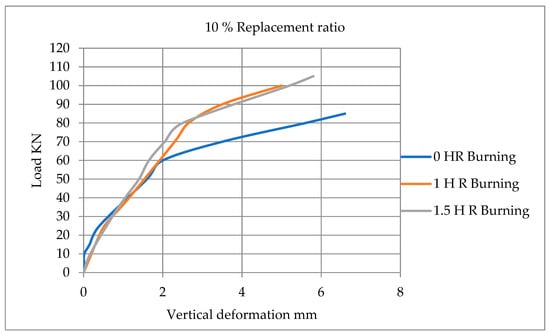
Figure 10.
Load–deflection curves of beams with a replacement ratio of 10%.

Figure 11.
Load characteristic of beams with a replacement ratio of 10%.
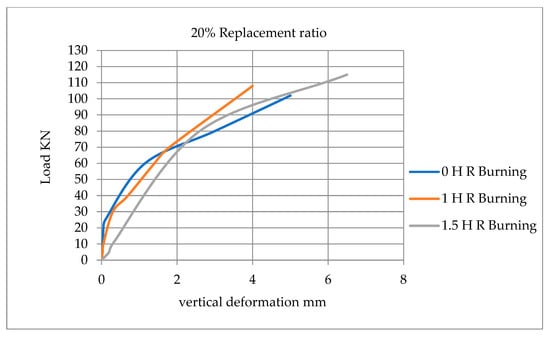
Figure 12.
Load–deflection curves of beams with a replacement ratio of 20%.
For the 20% replacement of glasses, group 3, the deflection at the yield load and the ultimate load were approximately equal to 0.5 mm and 6 mm for burning for one hour and a half, respectively. This indicates that by increasing the ratio of replacement glasses to 20%, the structural beam element became more brittle, as shown in Figure 13. The ultimate load strength increased by about 6 when the burning was one hour and 12 when the burning was one hour and a half compared with the beams without burning. That means the ratio of sand replacement by glass was 10%, which was the best.
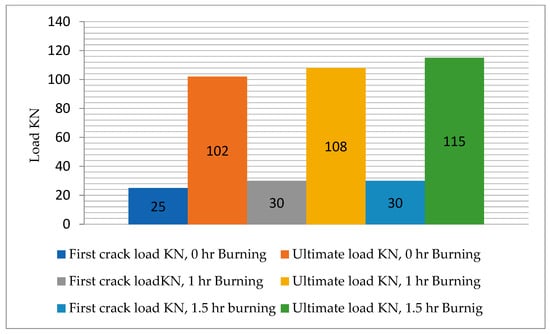
Figure 13.
Load characteristic of beams with a replacement ratio of 20%.
In addition, when comparing the two groups, G2 and G3, with the first group, G1, as a reference group, the characteristics of compressive strength, ultimate load capacity, and first crack load were considered, as shown in Table 4. It was observed that by replacing 10% and 20% of sand with glass with no burning, the physical properties of hard concrete, such as compressive strength, were improved, increasing by about 16% and 9%, respectively, and increasing about by 3–2% when the time of burning was one hour and one and a half hours, respectively.

Table 4.
Strength analysis of the tested specimens.
The flexural characteristics of beams shown in Table 4 show that the ultimate load capacity after burning decreased by about 5–20% for beams, but by replacing sand with glass, the ultimate load and the first crack load improved, and there was approximately the same load of beams without the replacement of sand with glass, especially when the ratio was 20%.
4.2.3. Mod Failure
The control beams malfunctioned as anticipated. In a conventional flexural failure mechanism, the yielding of the longitudinal steel reinforcement occurs, succeeded by concrete crushing in the upper third span of the beam. Cracks initiate on the lower surface of the beam at a load of 30 kN. Figure 13 illustrates that these fractures are aligned parallel to the first crack, which ascended from the free vertical edge of the slab to the slab’s compression face. The specimen ultimately failed under a load of 110 kN (see Figure 11 and Figure 13). Following combustion at two phases, it was seen that a compound shear–flexure failure occurred, resulting in flexural–shear failure. Flexural fissures developed at the lower surface of the beam, extending to the free edges and widening. The longitudinal rebars failed, and the concrete fractured after attaining its ultimate strain in the compression zone at the upper section of the slab. Cracks initiate on the lower surface of the beam at a load of 25 kN. Crack propagation and size are consistently escalating as the strain on the specimen intensifies. The specimen failed with an ultimate load of 115 kN. The exerted load aligns the fissures. Figure 14 illustrates two primary cracks in the concrete beams: shear cracks and flexural cracks. The remaining cracks are secondary and do not extend through the beam; they just affect the cover.
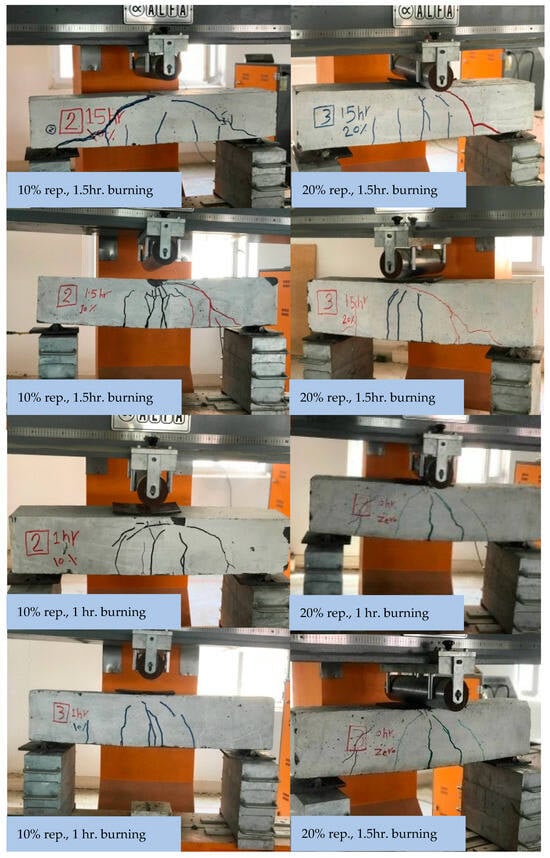
Figure 14.
Mod failure of beams.
5. Conclusions
Considering the variables analyzed in this study, several important conclusions have been reached regarding the structural performance of reinforced concrete beams containing waste glass when subjected to fire exposure.
- The compressive strength increased by about 10–29% by replacing 10% of sand with glass and by 1–16% with the increasing ratio when the replacement ratio of sand was 20%.
- The compressive strength would decrease by about 1–26%, and by increasing the time of burning from one hour to an hour and a half, the compressive strength decreased by about 20–51%.
- By replacing sand with 10% glass, the capacity of the first crack load increased by about 8% for burning for one hour and by 16% for burning for one hour and a half compared with the beams without burning, and the ultimate load capacity increased by about 17.5% when the burning was one hour and by 23.5% when the burning was one hour and a half compared with the beams without burning.
- By replacing sand with 10% glass, the ultimate load strength increased by about 6% when the burning was one hour and by 12% when the burning was one hour and a half compared with the beams without burning.
- The brittle failure happened when burning the beam element without sand replacement glasses.
- The replacement ratio (10%) is the best value of the replacement ratio if it is compared with the control and the ratio (20%), so it is useful to obtain a sustainable element by improving the properties of concrete.
- The replacement ratio (20%) is not adequate to improve the behavior of the beam element in this study.
- Replacing sand with glass leads to sustainable elements, and they can be used as structural elements.
Author Contributions
S.M.C. devised the project, the proof outline of the main conceptual ideas, and the measurements. H.H.H. was involved in planning and supervising the work. F.I.M. processed the experimental data, performed the analysis, drafted the manuscript, and designed the figures. S.F.R., R.T.H. and M.A.A. manufactured the samples and characterized them. F.S.H. performed the tests and calculations. N.M.H. listed the results and worked on the manuscript. All authors have written, discussed the results, and commented on the manuscript. All authors have read and agreed to the published version of the manuscript.
Funding
The authors declare that no funds, grants, or other support were received during the preparation of this manuscript.
Data Availability Statement
The original contributions presented in this study are included in the article.
Conflicts of Interest
The authors declare that there are no competing interests.
References
- Ombres, L.; Mazzuca, P.; Verre, S. Effects of Thermal Conditioning at High Temperatures on the Response of Concrete Elements Confined with a PBO-FRCM Composite System. J. Mater. Civ. Eng. 2021, 34, 04021413. [Google Scholar] [CrossRef]
- Ombres, L.; Mazzuca, P. Residual Flexural Behavior of PBO FRCM-Strengthened Reinforced Concrete Beams after Exposure to Elevated Temperatures. J. Compos. Constr. 2024, 28, 4318. [Google Scholar] [CrossRef]
- Debieb, F.; Kenai, S. The use of coarse and fine crushed bricks as aggregate in concrete. Constr. Build. Mater. 2008, 22, 886–893. [Google Scholar] [CrossRef]
- Al-Khatib, I.A.; Monou, M.; Abu Zahra, A.S.; Shaheen, H.Q.; Kassinos, D. Solid waste characterization, quantification, and management practices in developing countries: A case study of Nablus District—Palestine. J. Environ. Manag. 2010, 91, 1131–1138. [Google Scholar] [CrossRef] [PubMed]
- Khatib, J.M.; Mangat, P.S. Pore size distribution of cement pastes containing fly ash-gypsum blends cured for 7 days. KSCE J. Civ. Eng. 2002, 18, 1091–1096. [Google Scholar] [CrossRef]
- Menadi, M.; Kenai, S.; Khatib, J.M.; Aït-Mokhtar, A. Strength development and prediction of mortars containing limestone fines. In Proceedings of the 1st International Conference on Sustainable Built Environment Infrastructures in Developing Countries, ENSET, Oran, Algeria, 12–14 October 2009. [Google Scholar]
- Letsrecycle. Waste Crime Prosecutions Fall in 2012–2013. 2012. Available online: https://www.letsrecycle.com/news/waste-crime-prosecutions-fall-in-201213 (accessed on 14 October 2023).
- Poraver. 2012. Available online: https://poraver.com/en/poraver/ (accessed on 14 October 2023).
- Khatib, J.; Jefimiuk, A.; Khatib, S. Flexural behaviour of reinforced concrete. Slovak J. Civ. Eng. 2015, 23, 1–7. [Google Scholar] [CrossRef]
- Elizalde, R.R. Fire effects on reinforced concrete. J. Civ. Eng. Res. Technol. 2022, 4, 1–10. [Google Scholar] [CrossRef]
- Qasim, I.A.R. Some properties of mortar with crushed glass as fine aggregate. J. Tech. 2011, 24, A72–A78. [Google Scholar]
- Dabiri, H.; Sharbatdar, M.K.; Kavyani, A.; Baghdadi, M. The influence of replacing sand with waste glass particles on the physical and mechanical parameters of concrete. Civ. Eng. J. 2018, 4. [Google Scholar] [CrossRef]
- Zava, A.E.; Apebo, S.N.; Adeke, P.T. The optimum amount of waste glass aggregate that can substitute fine aggregate in concrete. Aksaray Univ. J. Sci. Eng. 2020, 4, 159–171. [Google Scholar] [CrossRef]
- Fernandes, S.C. Concrete production using fine glass aggregates as partial replacement of sand. Int. J. Innov. Educ. Res. 2019, 7, 428–439. [Google Scholar] [CrossRef]
- Gallagher, L. Sand and Sustainability: Finding New Solutions for Environmental Governance of Global sand Resources; United Nations Environment Programme (UNEP): Nairobi, Kenya, 2019. [Google Scholar] [CrossRef]
- Ahmed, M.F.; Abbas, A.H.; Abdulah, R.M. Using glass wastes as a fine aggregate in concrete mixture. Tikrit J. Eng. Sci. 2011, 18, 81–87. [Google Scholar] [CrossRef]
- Ali, E.E.; Al-Tersawy, S.H. Recycled glass as a partial replacement for fine aggregate in self compacting concrete. Constr. Build. Mater. 2012, 35, 785–791. [Google Scholar] [CrossRef]
- Adaway, M.; Wang, Y. Recycled glass as a partial replacement for fine aggregate in structural concrete—Effects on compressive strength. Electron. J. Struct. Eng. 2015, 14, 116–122. [Google Scholar] [CrossRef]
- Bisht, K.; Ramana, P.V. Sustainable production of concrete containing discarded beverage glass as fine aggregate. Constr. Build. Mater. 2018, 177, 116–124. [Google Scholar] [CrossRef]
- ASTM C33-03; Standard Specification for Concrete Aggregates. ASTM International: West Conshohocken, PA, USA, 2010.
- ASTMC494/C494M-17; Standard Specification for Chemical Admixtures for Concrete. ASTM International: West Conshohocken, PA, USA, 2017; pp. 1–10.
- ACI Code 318-19; Building Code Requirements for Structural Concrete. American Concrete Institute: Farmington Hills, MI, USA, 2019.
- ASTM A615/A615M-13; Standard Specification of Deformed and Plain Carbon Steel Bars for Concrete Reinforcement. ASTM International: West Conshohocken, PA, USA, 2013.
- BS EN 12390-3; Testing Hardened Concrete: Compressive Strength of Test Specimens. Incorporating Corrigendum August 2011. British Standards Institution: Milton Keynes, UK, 2009.
Disclaimer/Publisher’s Note: The statements, opinions and data contained in all publications are solely those of the individual author(s) and contributor(s) and not of MDPI and/or the editor(s). MDPI and/or the editor(s) disclaim responsibility for any injury to people or property resulting from any ideas, methods, instructions or products referred to in the content. |
© 2025 by the authors. Licensee MDPI, Basel, Switzerland. This article is an open access article distributed under the terms and conditions of the Creative Commons Attribution (CC BY) license (https://creativecommons.org/licenses/by/4.0/).